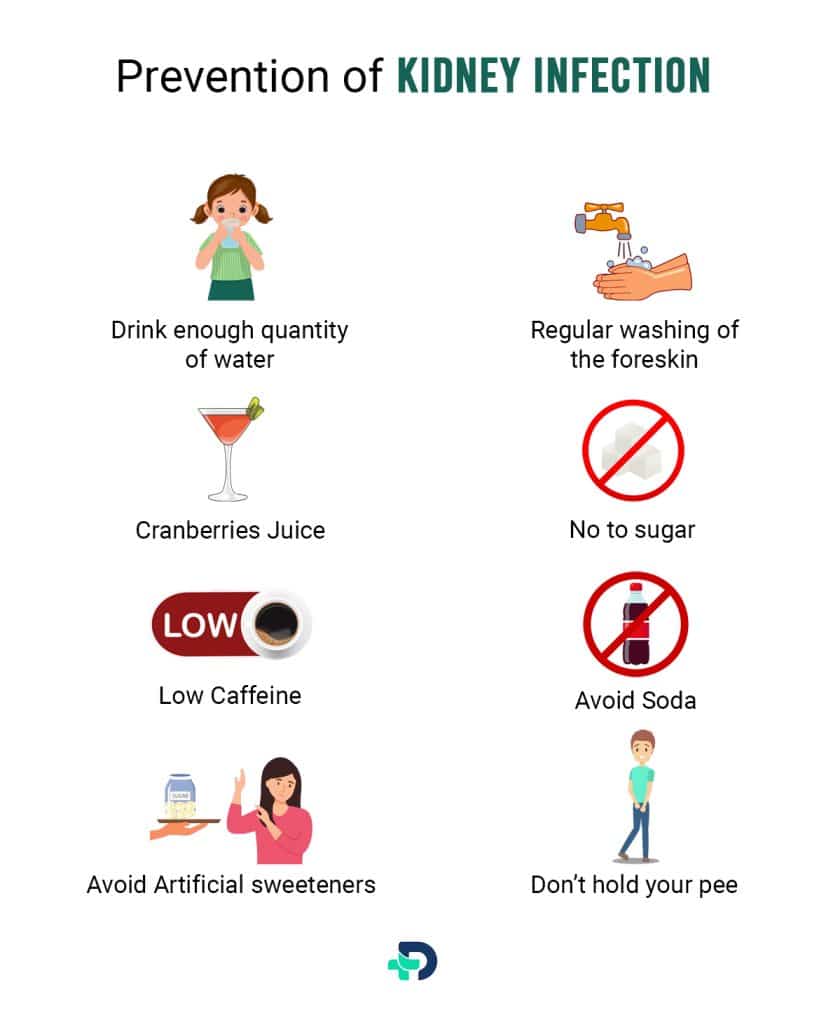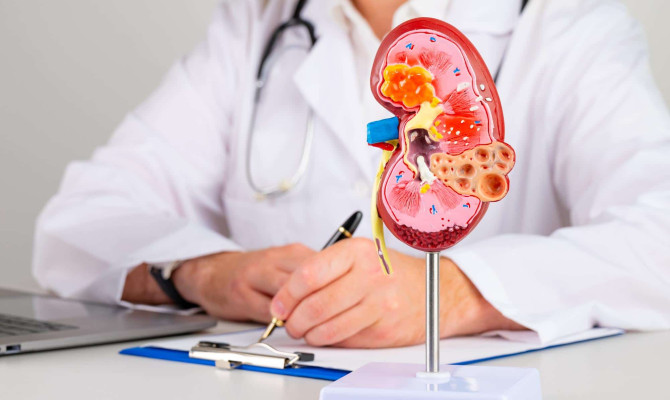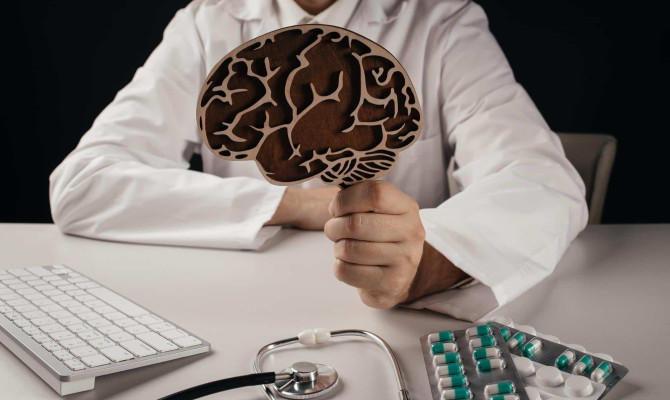Kidney Infection: Causes, Symptoms, and Treatment

- Kidney Infection
- 17 Aug 2023
Overview
Overview
Kidney infection is among a variety of infections that may affect the urinary system. Kidney infection is a widespread happening. It is specifically common among teens and young adult females.
About kidneys
The kidneys are situated on both sides beneath the diaphragm in closeness to the region of the lumbar spine. The kidneys are linked to the bladder through ureters. The elimination of urine (stored in the bladder) from the body occurs via the urethra. These structures comprise the urinary tract.
The kidneys execute various functions such as:
- Eliminate metabolic waste.
- Flush out drugs from the body and restore fluid balance.
- Absorb hormones for the regulation of blood pressure.
- Synthesize active vitamin D to enhance bone health and strength.
- Regulation of erythropoiesis (Production of red blood cells).1Overview| Researched based study from Nlm.nih.gov

Kidney infection
What is Kidney infection?
- A kidney or renal infection is also cited as Pyelonephritis. It is a really unpleasant health ailment. Pyelonephritis is the inflammation of the kidney. It is a sub form of urinary tract infection (UTI).
- The overwhelming majority of kidney infections come from bacteria or viruses. They initially affect the lower portion of the urinary canal. Later, the infection ascends to the upper urinary tract of one or both the kidneys.
- The human body possesses mechanisms to combat urinary tract infections. Normally, urine flows unidirectionally from the kidneys to the bladder. Urination prevents invading viruses and bacteria.
- The physiological mechanism of unidirectional urine flow works as a preventive measure against UTI.
- Postoperative kidney infection occurs due to bacterial infiltration during surgery. Then there will be via blood stream (hematogenous spread) to the kidneys.
A broader categorization of urinary tract infection includes:
- Lower urinary tract infection affects primarily the urethra, prostate gland, (in men) and bladder.
- Upper urinary tract infection pertains to kidney infection.
Causes
Causes of Kidney infection
- Escherichia coli(E. coli)2Causes| Researched based study from Nlm.nih.gov is the predominant species of bacteria responsible for the development of kidney infection.
- Kidney infections often arise supplementary to cystitis. Bacteria climb to the ureter to cause kidney infection. The bacteria typically found in the bowel, such as E. coli, are commonly involved. The majority of individuals with cystitis do not develop a kidney infection.
- Patients have kidney stones are highly prone to acquiring UTI.
Prevalence
Prevalence of Kidney infections
- Typically, a single kidney is affected by infection. Kidney infections can manifest at any stage of life. The occurrence of this condition is higher in females3Prevalence| Researched based study from Nlm.nih.gov Females are more vulnerable to bladder infections, which have the potential for transmission to the kidneys.
- The close location of the female urethra to the anus allows the transmission of bacteria from the bowel to the urethra. The female urethra’s shorter length encourages the flight of bacteria to the bladder.
- Children, older adults, and pregnant individuals are at a higher risk for kidney infections. They are infrequent in males
Risk factors
Risk factors for Kidney infection
Certain individuals are more susceptible to acquiring a urinary tract infection.
Risk factors for Kidney infections include:
- History of UTI.
- Sexually active life.
- Alterations in vaginal flora. (Menopause and spermicide use can induce bacterial alterations)
- Pregnancy.4Risk factors| Researched based study from Nlm.nih.gov
- Age is a significant risk factor for UTIs, with elderly people and young children being more susceptible.
- Structural urinary tract issues, such as prostate enlargement.
- Inadequate hygiene, particularly in children undergoing toilet training.
- Diabetes.
- Impaired immune system.
- Individuals with spinal cord injury or nerve dysfunction, such as multiple sclerosis, may experience bladder complications.
- Urinary incontinence (characterized by the involuntary leakage of urine)
- The presence of a catheter (a medical device that removes urine from the bladder).
- Obstruction of the ureter or kidney can occur due to factors such as the presence of a stone in the kidney or an enlarged prostate gland.
- Calculi in the kidneys and urinary tract irregularities are also potential etiologies of pyelonephritis. Urinary retention can lead to bacterial ascent to the kidney due to impaired urine drainage and blockage, which prevents the bacteria from being flushed out with the urine. Urinary tract infections can result from any obstruction to urine flow.
Is a kidney infection communicable?
- Kidney infection is usually noncommunicable illnesses as it results from the invasion of bacteria from the sexual organs or anal regions into the urinary tract.
Symptoms
Symptoms of Kidney infection
Symptoms manifest rapidly, typically within a few hours, and may comprise:
- Flank pain (it refers to the bodily region adjacent to the vertebrae at which the kidney is situated).
- Shivering might be brought on by a fever or high body temperature.
- Experiencing symptoms of nausea and/or vomiting.
- Diarrhea.
- Pee containing blood.
- Typically, symptoms of a bladder infection include dysuria and frequency.
- Clinical manifestations of kidney infection during examination may comprise fever, costovertebral angle tenderness, which refers to tenderness upon gentle tapping on the mid-back sides and infection.
Elderly individuals and immunocompromised patients may experience exacerbated kidney infections with
- Confusion.
- Lethargy.
- Swift heartbeat.
- Hypotension.
- Dehydration.
Common indications of a urinary tract infection comprise:
- Dysuria is the sensation of burning or pain during urination.
- Increased urinary frequency.
- Urinary urgency with inability to void.
- Experiencing urinary incontinence.
- Urine that appears cloudy, dark, malodorous, or tinged with blood.
Diagnosis
Diagnosis of Kidney infection
The diagnosis of UTI can be done by:
Urinalysis
- A dipstick urine test is a straightforward diagnostic procedure that can be performed by a medical practitioner. Urinalysis 6Diagnosis| Researched based study from Nlm.nih.gov is conducted by examining a urine sample using a specialized testing strip to detect indications of infection. The presence of kidney infection will be determined by this test.
- Additional testing may be recommended in certain circumstances, such as the presence of a renal stone or suspicion of a renal abnormality. Men and individuals with recurrent kidney infections are typically recommended to undergo testing. Ultrasound is typically the initial diagnostic test if additional examinations are required.
Urine culture
- Urinalysis is a diagnostic test that involves the cultivation and identification of microorganisms present in a urine sample.
- This is a laboratory examination aimed at cultivating potential bacteria detected in urine. It has the capability to ascertain the optimal antibiotics for treatment.
Urine-based DNA tests
- The purpose of this laboratory test is to extract the DNA of microbes present in urine and determine the bactericidal effects of various antibiotics.
If recurrent UTIs occur, additional diagnostic tests may be employed to evaluate the urinary tract’s normalcy. Possible tests include:
Digital rectal examination
- A male patient suspected of having a kidney infection may undergo a digital rectal examination (DRE) by a healthcare provider.
- A healthcare provider conducts a digital rectal exam by inserting a lubed finger into the patient’s anus to assess for the presence of an enlarged prostate obstructing the bladder neck.
Diagnostic imaging modalities
- Imaging tests, such as CT scan, MRI, or ultrasound, aid in the diagnosis of kidney infections by healthcare professionals. The tests are conducted by a technician in either an outpatient center or a hospital. A technician may conduct ultrasound in a medical facility.
Cystoscopy
- Cystoscopy is a diagnostic modality that entails the utilization of a cystoscope to optically examine the inside of the bladder through the urethra. The cystoscope is a slender instrument equipped by an optical lens and an illumination source located at its proximal end.
Renal and vesical ultrasonography
- This diagnostic modality employs high-frequency waves of sound to generate visual representations of both the kidneys and the bladder on a computer monitor. The test aims to assess the morphology of the bladder and kidneys, detect the presence of masses, kidney stones, cysts, or obstructions, and identify any anomalies.
Computed tomography (CT) scan
- Computed tomography (CT) is a technique in which X-rays are used. There is computer processing to produce high-resolution images of the human anatomy. A CT scan provides comprehensive visualization of bones, muscles, adipose tissue, and internal organs.
Recurrent UTIs may prompt a healthcare provider to conduct diagnostic tests to identify potential underlying conditions, such as diabetes or urinary system abnormalities, that could be associated with the infections.
Treatment
Treatment of Kidney infection
Treatment strategies for Kidney infection are as follow:
Antibiotics
- Antibiotics are the first line of treatment 7Treatment| Researched based study from Nlm.nih.gov for a kidney infection, before receiving the urine test results. Trimethoprim-sulfamethoxazole is widely used as the standard treatment for acute and persistent urinary tract infections due to its effectiveness against the common urinary pathogen
- The duration of antibiotic treatment ranges from 7 to 14 days, depending on the specific medication prescribed.
- Nitrofurantoin, Ciprofloxacin, Norfloaxacin, Cefalexin, Sulfonamides, co-amoxiclav, Fosfomycin and trimethoprim are frequently prescribed antibiotics for treating kidney infection.7Treatment| Researched based study from Nlm.nih.gov
- Oral antibiotics are generally effective in treating pyelonephritis. Hospitalization and IV antibiotics may be necessary if oral medication is not achievable due to severe illness or nausea.
Self-help initiatives
To solve UTI symptoms:
- Paracetamol can be taken up to four times daily to alleviate pain and fever. For individuals with UTI, paracetamol is typically preferred over NSAIDs like aspirin or ibuprofen.
- Liquid paracetamol can be administered to children.
- Adequate rest and hydration should result in the regular passing of pale urine throughout the day.
- Abstain from sexual activity.
- Prophylactic use of cystitis pouches or cranberry products may aid in the prevention of UTIs.
Approaches to relieve kidney infection pain
- Take an OTC painkiller
- Try to wear only cotton clothes so that moisture buildup can be prevented. This enhances comfort and also leaves no room for building up of bacteria.
- Apply heat with the help of a heating pad, warm washcloth, or even warm to hot water bottle. A warm bath will reduce pain and induce muscle relaxation.
- Add probiotics in your diet. Probiotics are believed to inhibit the adherence of pathogenic bacteria to urinary tract cells and reduce urine pH, thereby creating an unfavorable environment for their growth.7Treatment| Researched based study from Nlm.nih.gov
Prevention

Prevention of Kidney infection
The following measures can be taken to safeguard oneself from them:
Drink enough quantity of water
- It helps in elimination of bacteria.
Don’t hold your pee
- Void your bladder in response to the sensation of urinary urgency. Some children exhibit infrequent bathroom habits. Instruct your child to use the restroom multiple times throughout the day.
Practice front-to-back wiping after defecation
- Proper wiping technique is important to prevent UTI.
Use good amount of lube during intercourse
- Consider applying a modest quantity of lubricant, such as K-Y Jelly, prior to engaging in sexual activity if experiencing mild vaginal dryness.
Regular washing of the foreskin
- It is encouraged for individuals who are uncircumcised. It is important to educate uncircumcised boys on proper foreskin hygiene.
Cranberries, usually in the form of juice, are utilized for UTI prevention
- Cranberries possess a compound that inhibits bacterial adhesion to the bladder walls. This intervention may aid in the prevention of urinary tract infections, including those affecting the bladder.5Prevention| Researched based study from Nlm.nih.gov
Food to avoid in Kidney infections
No to sugar
A straightforward guideline to adhere to is: If you have a UTI, stay away from sugar. To reduce sugar intake and improve UTI care, avoid:
- Carbohydrates.
- Fried foods.
- Alcoholic beverages encompass beer, wine, and liquor.
Low Caffeine
- Caffeine increases bladder infection symptoms by irritating the bladder. Consider substituting your morning coffee routine with a cup of non caffeinated herbal tea until the resolution of your urinary tract infection.
Avoid Soda
- Sodas may further inflame the bladder in people who suffer from persistent bladder inflammation.
Avoid Artificial sweeteners
- While there is no proof that artificial sweeteners can aggravate a UTI, they have been demonstrated to worsen bladder symptoms in people with chronic interstitial cystitis. Therefore, it is suggested to avoid consuming them.
Additional food and drink items to abstain from when experiencing a UTI are:
- Spicy foods can cause bladder irritation. It is recommended to adhere to a bland diet when experiencing a UTI.
- Citrus fruits such as oranges, lemons, limes, and grapefruits, despite being rich in vitamin C which enhances immunity, possess high acidity levels that can cause bladder irritation and exacerbate symptoms of urinary tract infections.
Complications
Complications of Kidney infection
Kidney infections may result in complications like:
- Chronic lower urinary tract symptoms.
- Kidney dysfunction.
- Staghorn calcium deposits in the urinary system.
- Chronic prostatitis
- Prostatic abscess (presence of an abscess, or a localized collection of pus)
- Renal nephronia.
- Pyelonephritis.
- Scarring
- Emphysematous pyelonephritis (commonly in diabetics)
- Blood infection.
- No control on bladder and bowel habits.
- Renal abscess (localized collection of pus within the kidney)
- Kidney failure.8Complications| Researched based study from Niddk.nih.gov
Bottom Line
The Bottom Line
Urinary tract infection is a frequently occurring infectious disease that affects individuals of both sexes, although it is more prevalent among women due to their physiological makeup and pregnancy.
Furthermore, advanced age is a major contributor to the exposure of urinary tract infections among people utilizing urinary devices such as catheters. Thus, you must keep a note of symptoms. You should keep a regular record and follow up of your treatment and opt for healthy foods.
Any feedback on this article?
 This Articles content was accurate
This Articles content was accurate Very Informative Article
Very Informative Article I have a question or a comment
I have a question or a comment
 This article contains inaccurate content
This article contains inaccurate content This article was not helpful
This article was not helpful I have a question or a comment
I have a question or a comment
We appreciate your helpful feedback!
Checkout our social pages
References
-
National Library of Medicine
Erythropoiesis: Development and Differentiation | Overview
-
National Library of Medicine
Urinary tract infections: epidemiology, mechanisms of infection and treatment options | Causes
-
National Library of Medicine
Urinary tract infection in women | Prevalence
-
National Library of Medicine
Urinary Tract Infection in Pregnancy | Causes
-
National Library of Medicine
Cranberries for preventing urinary tract infections | Prevention
-
National Library of Medicine
Urinary Tract Infection | Diagnosis
-
National Library of Medicine
Management of uncomplicated urinary tract infections | Treatment
-
National Institute of Diabetes and Digestive and Kidney Diseases
Definition & Facts of Kidney Infection (Pyelonephritis) | Complications






































